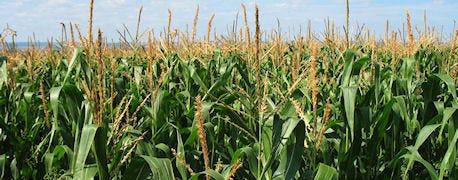September 3, 2012

What should you pay for corn silage if you chop it out of a neighbor's field?
When you chop out of the neighbor's field, you get corn grain and fodder for feed. Add what you pay the neighbor and your harvest cost, and you come up with your cost per pound or ton of feed.

Buying Corn Silage Out Of The Field
One of the common guidelines for determining a dollar value for normal corn silage as it stands in the field is to multiply the price for a bushel of corn by six, seven or eight, and that would give a price we might pay for a ton of corn silage. For example, if you used seven and multiplied it by the price of corn at $7.50, you would pay $52.50 per ton of corn silage. This is based on the concept that normal corn silage is likely to have six to eight bushels of corn in a ton of corn silage.
Some people suggest subtracting the cost of harvesting the silage from this value because if you bought corn in town at the same price, you would not have a harvesting cost. Some suggest adding a value for the forage part of the silage. The forage component might be based on the value of grass hay that has similar quality to the corn fodder material. Some suggest putting a value on the fodder based on the fertilizer value of the nitrogen, phosphorus and potassium in the fodder.
Moisture at chopping is a huge factor. As the grain matures and dries it becomes a larger portion of what you are weighing in filled silage box or truck box. If the corn yield is 150 bushels per acre, and you're chopping at 65% moisture, the corn silage yield is expected to be around 20 tons per acre with about 7.5 bushels per ton. If the same corn was chopped at 60% moisture (less water) the yield drops to 17.7 tons per acre with 8.6 bushels of corn per ton. If the same corn is chopped at 70% moisture (more water) the yield goes up to 23.3 tons per acre with 6.4 bushels of corn per ton. Moisture counts.
The grain per ton ratio also varies with different hybrids and the weather. Weather could be a significant factor this year. Limited moisture earlier in the growing season might limit plant growth. With good rain for pollination and grain fill, you might have a good grain yield on a smaller plant. You could have the opposite - lots of stalk growth followed by dry weather with lower grain yield. From 1997 to 2005 with silage adjusted to 65% moisture, the bushels of corn per ton with a 150 bushel corn yield varied from 6.4 to 9.2.
Another approach would be to leave a test strip in field that is combined later. Buyers and sellers need to agree on where in the field strips would be left to be representative of the field. This would need to fit with baling stalks, fall tillage, applying manure or other work the land owner wants to do in the fall. Usually corn that is chopped for silage is close to maturity and randomly hand picking ear samples, as crop insurance adjustors do, might give pretty good clues about grain yield. People need to decide how much they want to try measuring something and how much they want to guesstimate.
For more information, search the Minnesota Extension and Wisconsin Extension websites.
-By Dan Martens, University of Minnesota Extension
You May Also Like




